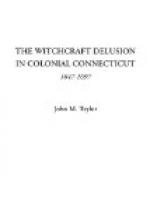Mercy Disborough, and another woman on trial at the same time (Elizabeth Clauson), were put to the test together, and two eyewitnesses of the sorry exhibition of cruelty and delusion made oath that they saw Mercy and Elizabeth bound hand and foot and put into the water, and that they swam upon the water like a cork, and when one labored to press them into the water they buoyed up like cork.[G]
[Footnote G: Depositions of Abram Adams and Jonathan Squire, September 15, 1692.]
At the close of the trial the jury disagreed and the prisoner was committed “to the common goale there to be kept in safe custody till a return may be made to the General Court for further direction what shall be don in this matter;” and the gentlemen of the jury were also to be ready, when further called by direction of the General Court, to perfect their verdict. The General Court ordered the Special Court to meet again “to put an issue to those former matters.”
October 28, 1692, this entry appears of record:
“The jury being called to make a return of their indictment that had been committed to them concerning Mercy Disborough, they return that they find the prisoner guilty according to the indictment of familiarity with Satan. The jury being sent forth upon a second consideration of their verdict returned that they saw no reason to alter their verdict, but to find her guilty as before. The court approved of their verdict and the Governor passed sentence of death upon her.”
The hesitation of the jury to agree upon a verdict, the reference to the General Court for more specific authority to act, all point to serious question of the evidence, the motives of witnesses, the value of the traditional and lawful tests of the guilt of the accused.
In the search for facts which the old records certify to at this late day, one is deeply impressed by the wisdom and potency of the sober afterthought and conclusions of some of the clergy, lawyers, and men of affairs, who sat as judges and jurors in the witch trials, which led them to weigh and analyze the evidence, spectral and otherwise, and so call a halt in the prosecutions and convictions.
What some of the Massachusetts men did and said in the contemporaneous outbreak at Salem has been shown, but nowhere is the reaction there more clearly illustrated than in the statement of Reverend John Hale—great-grandsire of Nathan Hale, the revolutionary hero—the long time pastor at Beverly Farms, who from personal experience became convinced of the grave errors at the Salem trials, and in his Modest Inquiry in 1697 said:
“Such was the darkness of that day, the tortures and lamentations of the afflicted, and the power of former precedents, that we walked in the clouds and could not see our way.... observing the events of that sad catastrophe,—Anno 1692,—I was brought to a more strict scanning of the principles I had imbibed, and by scanning to question, and by questioning at length to reject many of them.” Nathan Hale (p. 10), Johnston.




